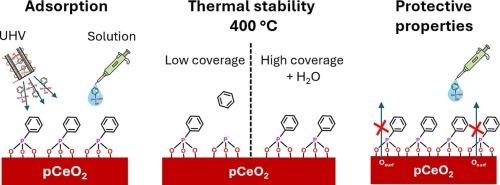Functionalization of the polycrystalline cerium oxide with phenylphosphonic acid molecules
IF 6.9
2区 材料科学
Q2 CHEMISTRY, PHYSICAL
引用次数: 0
Abstract
This work reports a study of the functionalization of polycrystalline cerium oxide (pCeO2) films by the phenylphosphonic acid (PPA) molecules deposited either in vacuum or from aqueous solution. The systems are characterized using synchrotron-based techniques, including core-level and valence-band photoelectron spectroscopy, resonant photoemission and near-edge X-ray absorption spectroscopy. PPA binds strongly to the pCeO2 surface via the phosphonate group in a tridentate geometry, accompanied by deprotonation of the P–OH groups and the formation of surface hydroxyl groups. The binding configuration is independent of molecular deposition technique and oxide surface morphology. Thermal stability analysis reveals that low coverage PPA adlayers (0.07 ML) are prone to desorption and decomposition upon heating. In contrast, high coverage adlayers (0.17 ML), particularly those formed in the presence of water, exhibit higher thermal stability as no molecular decomposition was observed up to 400 °C. The deposition of PPA from aqueous solution is found to protect the surface of pCeO2 films from reduction. The results contribute to the understanding of phosphonate–cerium oxide interactions by highlighting the influence of the deposition environment and surface morphology on molecular bonding and stability.

多晶氧化铈与苯膦酸分子的功能化
本文报道了用苯膦酸(PPA)分子在真空或水溶液中沉积的多晶氧化铈(pCeO2)薄膜的功能化研究。使用基于同步加速器的技术,包括核能级和价带光电子能谱,共振光发射和近边x射线吸收能谱,对系统进行了表征。PPA通过磷酸盐基团以三叉戟的形式与pCeO2表面强结合,并伴随着P-OH基团的去质子化和表面羟基的形成。结合结构与分子沉积技术和氧化物表面形貌无关。热稳定性分析表明,低覆盖率PPA涂层(0.07 ML)在加热时容易解吸分解。相比之下,高覆盖率层(0.17 ML),特别是在有水存在的情况下形成的层,表现出更高的热稳定性,因为在400 °C以下没有观察到分子分解。发现PPA在水溶液中的沉积可以保护pCeO2膜表面不被还原。这些结果通过强调沉积环境和表面形貌对分子键和稳定性的影响,有助于理解磷酸盐-氧化铈相互作用。
本文章由计算机程序翻译,如有差异,请以英文原文为准。
求助全文
约1分钟内获得全文
求助全文
来源期刊

Applied Surface Science
工程技术-材料科学:膜
CiteScore
12.50
自引率
7.50%
发文量
3393
审稿时长
67 days
期刊介绍:
Applied Surface Science covers topics contributing to a better understanding of surfaces, interfaces, nanostructures and their applications. The journal is concerned with scientific research on the atomic and molecular level of material properties determined with specific surface analytical techniques and/or computational methods, as well as the processing of such structures.
 求助内容:
求助内容: 应助结果提醒方式:
应助结果提醒方式:


